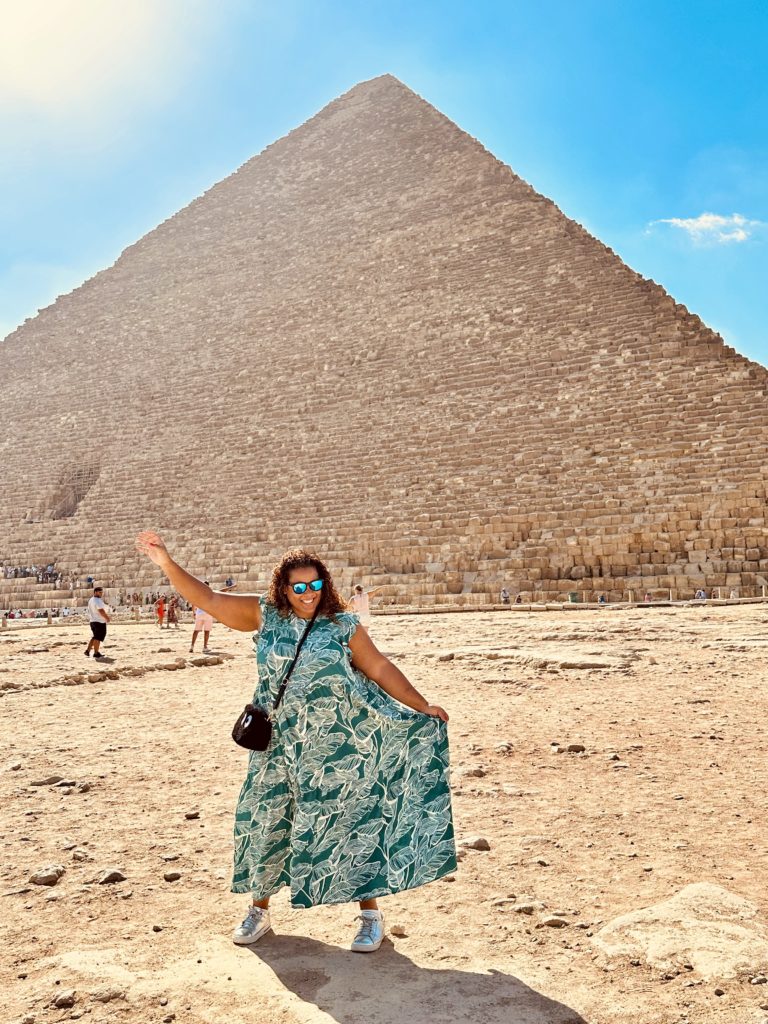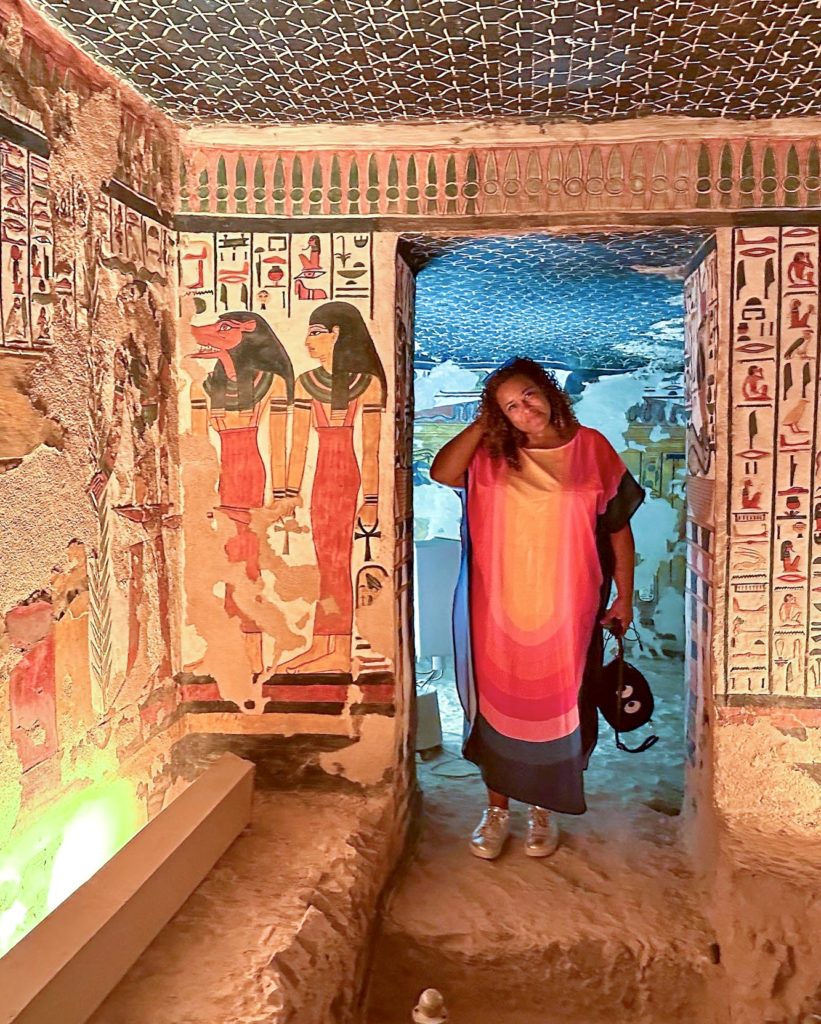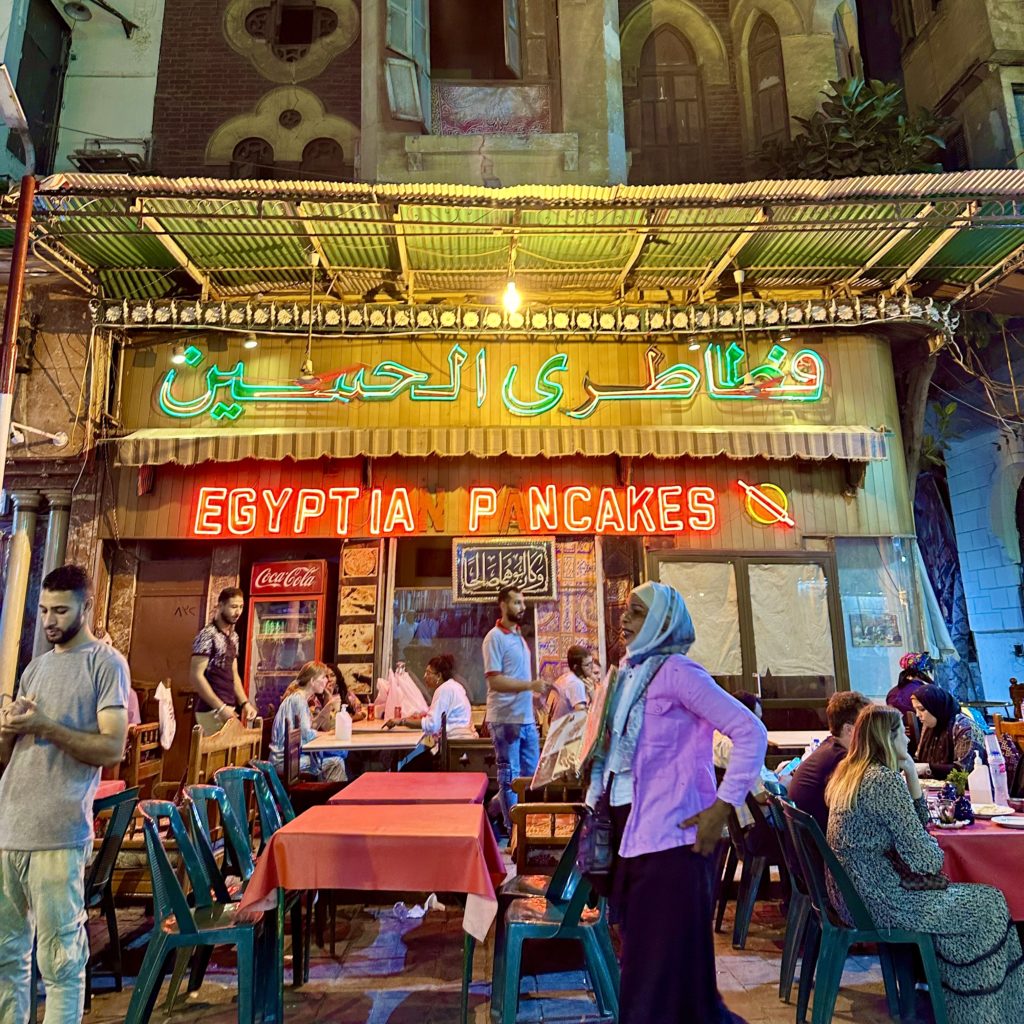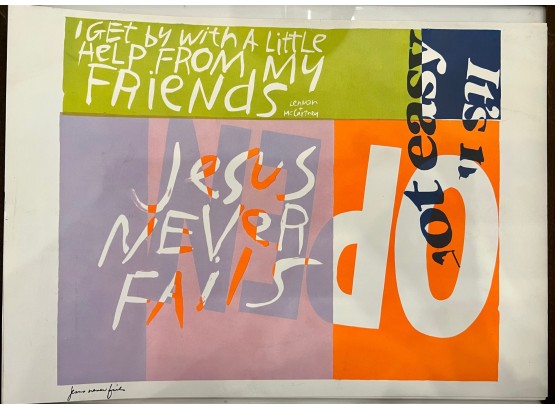Treks and Memorials
This week we follow the journeys of Dodai Stewart, Max Pearl, and Rick Paulas and check in with the manager of the Elizabeth Wurtzel estate sale

New York Times writer-at-large Dodai Stewart visiting Egypt.
A cold week like this past one can leave one feeling pretty anti-social and wanting nothing more than to curl up at home, sip soup, and call up members of the media community who had the gumption to explore faraway places like Egypt, South Korea, and Greenpoint.
VOYAGES
Ever since New York Times writer-at-large Dodai Stewart spent her days wandering the Met as a kid, she’s wanted to travel to Egypt. “I took after-school classes there and I was obsessed with The Temple of Dendur,” she said. “Somehow I made it all these years without going. I had a very big birthday this year and I was like, ‘I can’t get any older and not go to Egypt.’” She got back last Thursday after staying six nights in Cairo and Luxor. “I had high expectations, and I was so excited, and then it was even better than I thought it was gonna be. It blew me away,” she said. “The scale of the pyramids and thinking about them being from 2500 BC is mind-boggling. When you see how big the bricks are, it’s just unreal.”
In Luxor’s Valley of the Queens, Stewart was struck by the tomb of Nefertari, wife of Ramesses the Great(“Look on my Works, ye Mighty, and despair!”). Nefertari’s resting place was unearthed in 1904 by Ernesto Schiaparelli, a cousin of the designer, but it had been relatively inaccessible until recently. “My guidebook said something like, ‘Oh, nobody goes inside this one. You have to write a letter to the Egyptian state department.’ It was a whole thing. And then my tour guide was like, ‘No, they’ve opened it up now,’” Stewart said. “The colors are so vivid, and she was a very beautiful queen. Everything that you can imagine — all the hieroglyphs, all the colors — and you’re inside this sacred space. It was just so beautiful.”

Having seen the graffiti on Dendur, Stewart knew to look for more recent additions to the ancient structures. Though she didn’t find any on Nefertari’s Tomb, she found British etchings elsewhere in Luxor. “I saw something from like 1820, I think. Somebody had carved their name in a column,” she said. “It’s pretty funny, but at some point, that becomes historic too.”
Modern Egypt proved as impressive. “I was really shocked by the scale of Cairo, which has 25 million people. I’m a New Yorker, I grew up in a big city, and I was like, ‘Oh, this is a really big city,’” Stewart said. [The official figure from the Egyptian government is just north of 21 million.] “They have famously terrible traffic, and also the way people drive — there’s no lanes, there’s no streetlights, everything is a suggestion. You cross the street whenever you want, and you just make eye contact and they stop for you. It was very intense, so dense, so crowded, so busy, and I kind of loved it.” Even individual vehicles were crowded. “There are sometimes four people to a motorcycle, and two of them are kids,” Stewart noted, “which was really fun.”
Through most of Stewart’s time in Egypt, the temperature hovered around 95. “When I left New York, it was still in the 70s, so to come back and it’s in the 40s and 50s, I was like, ‘Well, this is rude,’” she said. “It’s different when it’s gradual, but it was more of a shock and the landlord hasn’t turned my heat on yet. I was looking at my radiators, like what is happening?” But there were some fun aspects to her return. “I literally used the CVS app to upload some pictures and print them at CVS. I just picked them out today, because I’m going to glue them in my journal, so that’s how excited I am about this whole thing,” she said. “It’s an ongoing journal where I write but then, lately, I’ve been taping pictures inside because it satisfies my blogger need for pictures and words — my former blogger need.”

The Nation and New York contributor Max Pearl had never been to Asia before spending the last two weeks in South Korea. “My wife is Mexican, so whenever we have vacations, we always go to Mexico to see her friends and our mutual friends and her family. And so we thought, what could be a bigger, further afield trip?” he said. “Up until two weeks ago, they were testing you upon arrival, which was a little harrowing, because what if I get COVID the night before and then I have to get on this airplane and then I get off the airplane and then I have COVID? So we were lucky because they lifted that requirement.”
Pearl’s uncle had previously traveled to South Korea and told him he had to visit the DMZ. “It was kind of a mind trip to see this bizarre phenomenon while it still exists,” Pearl said. The anomalous haunted aspect of it was somewhat lessened by the tourist infrastructure, including a Dunkin’ Donuts. “It’s almost like a theme park,” he said. “You get on a bus. They drive you to a few of the sites that they’ve turned into a small museum, one of which is a tunnel that the North Korean army secretly dug to sneak people and goods across the border. So we got into this four-and-a-half-foot high funnel where you have to crouch, and it’s making dripping noises.” From the tunnel, Pearl stepped onto a vantage point where he could survey the skyscrapers of a North Korean city.

Initially, they’d planned to check out the beaches on the island province Jeju, but because of uncooperative weather, they ended up sticking mainly to Seoul and Busan. Pearl was particularly excited to check out the vibrant contemporary art scene. “A couple of my friends who work in the arts have come over here to do stuff,” he said. “I get the sense that a lot of the museums and gallery stuff is sort of a soft power thing. For whatever reason, having a high density of modern world-class museums is beneficial to whatever the current nation-building project is, so you get the sense that the government and the corporations are putting all this money into art because it’s good for the country’s image.”
At the Busan Biennial, Pearl was entranced by a series of paintings by Oh U-Am, an artist born in 1938 who depicted Korean urban scenes shifting over his lifetime. “It was almost comic book style, but not quite a narrative,” he said. “One of the first paintings is a really depressing scene of farmhouses on fire and villages being ransacked by an invading army, and then the last painting is a subway with all these young hipsters looking at their iPhones.”
Pearl is flying back tomorrow, having gotten his fill of travel for now. “At the end of two weeks is when you start to feel the twinge of homesickness and miss your friends,” he said.
PURSUITS
Taking advantage of a pandemic deal, New York Times and Vice contributor Rick Paulas moved to Greenpoint from East Williamsburg in February of 2021. “The streets were pretty empty. There was just the wind rustling off the East River through these high rises,” he recalled. “There were all these structures that were in the middle of being completed, but all the construction got put on hold during that time, so it was just these abandoned high rises at the edge of the water.” Amidst that halted progress, there was a sense of ancient arcana half-articulated by the neighborhood, though Paulas couldn’t quite pin it down. He started writing a story set around him to try to understand it. The result is a three-mile-long audio ghost story that unfolds across the neighborhood called The Lady in Greenpoint.
“I got 45,000 words into a story or a book or something, I wasn’t sure, but I was getting stuck and I didn’t know exactly what to do with it,” Paulas said. In March, while having a drink with his girlfriend, he landed on the idea of a walking audiobook and decided that he wanted to have it done for the Halloween season. “That eats up half the year, which is great, and then I don’t have to work on other creative pursuits,” he said. “I think a lot of this is just what can keep myself occupied for a year so I’m not losing my mind trying to figure out what to do.”
The first step was to figure out how the story would progress geographically. “Once I had the path, it took me a weekend to write the first draft, because I had all the characters and all the story set up from the previous non-book,” he said. “I had a microphone that I borrowed from a friend and I walked the path with the microphone recording and that helped a lot because then it was like, alright, the first segment, basically it goes over the Pulaski Bridge and that, I found while walking and tape recording, was a six-minute track.” He worked up a version where he did every one of the 50 or so voices, fine-tuning it before getting friends to send him their voices to add to the mix.
Paulas did his first walk-through in the middle of September before releasing the story at the end of the month. As it’s gotten colder, the spookiness has increased, but it has also, at times, gotten quite unpleasant to be outside. “Ideally, it would be 55, 60 degrees at night and kind of gloomy and overcast, but otherwise not super breezy,” Paulas said. “There is a spooky element to this whole thing, but at the same time, I understand that it’s cold, and people don’t want to spend three and a half hours walking around outside.” But there’s no reason why the walk can’t wait until things warm up a bit. “I personally don’t even want to do it when it gets this cold,” Paulas said. “It’s up to people if they want to brave it or not, but as long as Greenpoint doesn’t flood over, it’ll be around.”
In the meantime, Paulas is celebrating Halloween in other ways. “This weekend I’m going for a haunted hayride up in Tarrytown,” he said. “Next weekend, there’s a night tour of Greenwood Cemetery that we’re gonna do.” He concluded, “This season kicks ass.”
PASSAGES
After Prozac Nation author Elizabeth Wurtzel died in 2020 of breast cancer at 52 years old, the contents of her apartment were moved into storage. Her mother went through the accumulated objects, picking out some prized Jonathan Adler pieces, before passing many of them on to the online auctioneers Metafair, who sold them off in sales held on Wednesday and Thursday. “There were hundreds and hundreds of boxes,” said Metafair co-founder Donna Drimer, estimating that there were around 1,200 books among everything else. “She had quite an extensive library. I have somebody coming in on Friday for the books that I haven’t been able to get to — she specializes in women’s books and first editions. There are a lot of female authors and books on feminism.”
A separate dealer is trying to place Wurtzel’s manuscripts with a university library, and the items in these auctions were more on the level of personal effects, including several extensive, not to say obsessive, collections. “She has a lot of Yale things and some Harvard things,” Drimer said. Wurtzel wrote for The Harvard Crimson as an undergraduate and worked at The Dallas Morning News around the same time as New York Times executive editor Joe Kahn hurtled down the same trajectory. In 2007, at age 40, she completed a law degree at Yale. “She’s got tons of images of the law library and different buildings.” Some of the items were less autobiographical. “She has some civil rights posters that I was surprised but thrilled to see for the Black Panthers,” said Drimer. “She obviously had a thing for skulls, also for rams.” Some were downright esoteric. “She collected prints by Sister Corita,” said Drimer. “She was a nun who was an artist and made, in the ’60s and ’70s, artworks made into posters, very available, price-wise. Surprisingly, she had about ten of them. She was a fairly religious woman, and she was Jewish, so for her to collect the Sister Coritas was interesting.”

A 1968 print by Sister Corita, which sold at auction for $140.
“Today should be even crazier,” Drimer said on Thursday afternoon. “She actually writes about her first Birkin bag being stolen” — “When I got a huge advance for Bitch, my second book,” Wurtzel wrote in a 2013 New York magazine essay, “I bought a Birkin bag, which Maria [a woman who stalked her] has since stolen” — “and she replaced it, so we have her Birkin bag up tonight, so that should be interesting. We have a couple of thousand views on that, which is tremendous.”
UPCOMING
Monday
➾ 7 p.m. Lux magazine contributor Yasmin El-Rifae will discuss her debut book Radius with artist and New York Times contributor Molly Crabapple and Lux editor-in-chief Sarah Leonard at McNally Jackson Seaport.
➾ 7:30 p.m. Foreign Policy, New Republic, and New York Times contributor Anna Badkhen will discussher new essay collection Bright Unbearable Reality with New Yorker staff writer Masha Gessen at the Greenlight Bookstore in Fort Greene.
Tuesday
➾ 5:30 p.m. Rest of World will host a happy hour for current and former staff in the Financial District.
➾ 6 p.m. Host of the Fast Politics podcast and Atlantic newsletter writer Molly Jong-Fast and Craigslist founder Craig Newmark will host a party to celebrate the release of former Washington Post media columnist and New York Times public editor Margaret Sullivan’s memoir Newsroom Confidential at a private club in Midtown.
➾ 7:30 p.m. New York magazine veteran Mark Jacobson will present The Suitcase Opens, three short pieces for film and stage — all based on actual events — at the Kraine Theater in the East Village.
Monday
➾ 6:30 p.m. National Magazine Award winner and software services provider Paul Ford will host a party for his new app Aboard near Union Square. “When I’m not being held to task for the work I did four years ago for The Baffler, I am launching a startup that can be used for editorial workflow among many other things,” Ford told The Fine Print when he shared the invite.
➾ 7 p.m. Penta magazine senior editor Mitch Moxley and Bloomberg Businessweek contributor David Gauvey Herbert will host the third edition of The Night Editor, a series of storytelling, readings, and interviews at Down & Out Bar in the East Village. Presenters for this issue will include New York Timesdocumentarian Leslye Davis and former Sports Illustrated executive editor and Anthony Bourdainbiographer Charles Leerhsen.
➾ 7 p.m. New York Review of Books contributor and novelist Darryl Pinckney will discuss his new memoir, Come Back in September, focused largely on his mentee relationship with Elizabeth Hardwick, with New York Times contributor Kate Bolick at McNally Jackson Seaport.
Thursday
➾ 7 p.m. Artist and Deadhead Mark A. Rodriguez will discuss his new book After All Is Said and Done: Taping the Grateful Dead, 1965-1995 with Paris Review web editor Sophie Haigney and Wired and Pitchfork contributor Jesse Jarnow at McNally Jackson Williamsburg.
Have a moment? Let us know!
